The Making of a Sewing Diva
A good Garment Center-style fabric store still makes me swoon. Here's why.
I learned to sew when I was in sixth or seventh grade. My mother taught me. When I was younger, she made most of my clothes, usually frilly dresses for church and special occasions. She made my First Communion dress, and some of my everyday school dresses, jumpers and blouses. We didn’t wear pants to school back then, at least not when I was in elementary school.
Looking back at some of the thoughtless ideas of youth, I also remember when I didn’t want to wear her clothes anymore. I wanted “store-bought clothes” like everyone else. I’ll never forget an outfit I bought, well, my mother bought, because I pestered her to death. It was a 3-piece pantsuit in a small pink and white flower print in cotton poplin or broadcloth. It had a jacket, pants and a short skirt. Respectably short, not mini-skirt short. I loved that suit. My mother could have made something similar, but I wanted this off-the-rack outfit. It came from a discount department store called Jamesway, in Oneonta.
I also really, really wanted white go-go boots. They were the hottest fashion accessory of the day, worn by pop stars, Nancy Sinatra, super spy Emma Peel and all the cool people who shopped on Carnaby Street in London, as seen on television and in magazines. Jamesway had vinyl go-go boots. My parents really couldn’t afford to buy them for me, but I saved up about half the price from my allowance, and I was finally able to get them. We went to the store and they were out of my size.
I was devastated. I wanted them so badly, I bought a pair that was a half size smaller than what I actually wore and convinced my mother that they fit just fine. I squeezed my feet into them, and proudly wore them to school with my pink suit. I thought I was truly a fashion plate. Needless to say, I suffered for my fashion. My feet were killing me. I couldn’t wear them if I was going anywhere where I’d have to stand or walk for any length of time. Lesson learned, at least until much later in life. I have a sneaky suspicion that my Mom knew they hurt, but you know how hard-headed kids are. Sometimes you just have to get burned to learn not to put your hand in fire.
(British designer Mary Quant in 1966 via Wikimedia)
I took to sewing very quickly. I got it. By the time I had to learn how to sew in home economics. I was already making my clothes. I told the teacher I knew how to sew already, but she totally wasn’t having it. She didn’t much like me anyway, and I HATED Home Ec. I wanted to take shop, but girls were not allowed to take shop. She was not the best sewing teacher either. For our first class sewing project everyone had to choose a really easy skirt or dress pattern, one with simple lines, and nothing complicated like tucks or gathering or lots of pieces. Since she finally acknowledged that I could sew, she allowed me to choose a dress that was a bit more complicated.
If you know anything about sewing, commercial home sewing patterns are marked with 5/8” seam allowances (generally speaking). Sewing machines have measurements on the plate next to the needle that one can use as a guide when sewing a seam. You place the raw edges of the fabric at the line that indicates the width of your seam. When everyone was learning the basics like sewing a straight seam, she had them mark the stitching line with marking paper.
(Photo: treasurie.com)
Marking or tracing paper is a colored double-sided paper similar to carbon paper. Some of you remember carbon paper, right? It is placed on the wrong sides of your cut pattern pieces, and a rotating wheel that looks like a small pizza cutting wheel with notched edges traces the seam lines that are marked on the paper pattern. The paper only came in primary colors like red, navy blue, yellow and white. You used a color that would show up on the fabric. Then you simply guided the machine needle to sew on the dotted lines.
I hated marking paper. Unless you were using really thick fabric, the colors always bled through to the right side. If you weren’t very good at guiding the needle, you could miss, and when you turned your garment, you could often clearly see the dotted lines. But our teacher insisted on using it for everything. She wanted her student to mark every seam in the garment, even easy seams like a side or back seam, which, in the simple patterns we were using, was just a straight line.
I didn’t need marking paper, and I was taught to only use it to mark darts or pockets or some other special feature that had to be visible when you removed the patterns from the fabric. But she made me mark every seam anyway. It was a total waste of time. When I look at pattern pieces, I get them. It’s a matter of human anatomy. A set-in sleeve needs a cap at the shoulder to allow for movement of the arm. The front and back of a dress are different for a reason. We have derrieres. Darts give a garment shape, and allow for breasts, or hips. For me, even back then, I could read a pattern like a book. You either got it, or you didn’t.
Some of my classmates didn’t get it. At all. I distinctly remember the student who sewed the two sleeve pieces together. She went around all four sides. She really didn’t understand what a sleeve was, or why it was. At the end of the semester, though, everyone completed their garment, and had to wear it. My dress was in a truly awful print that I thought was great at the time, but I wouldn’t touch with a ten-foot pole now. I didn’t like how it turned out anyway, and never wore it. Home Ec. Bah!
There weren’t a lot of places to buy fabric around Gilbertsville. There was a store called Brazee’s in Oneonta. It was the largest and fanciest store in the area. It was much more upscale than a place like Jamesway, and the store, which was on Oneonta’s main shopping street, was the only store for miles around that had an escalator. It only went up one or two floors, but it was quite the attraction. When we went shopping there, we couldn’t wait to ride the escalator.
Brazee’s had a fabric and pattern department. They had nice fabric, stuff that was fashion forward for its day. I remember I bought my first Qiana knit jersey fabric there, to make a blouse, as well as suit-weight double knits. Yes, I’m a child of the 1960s and early 70s. Qiana was awesome stuff. It looked like silk, and never wrinkled and could come in beautiful solids and prints. It was a really popular fabric introduced by DuPont In 1968. You had to really know how to sew, though, because the stuff was also slippery.
Double knits also came out around then. Both Quiana and the knits were polyester, new fabrics introduced during that period. They didn’t wrinkle. EVER. You could pop those babies in the washing machine and dryer and they were good to go. Growing up where you had to iron EVERYTHING, they were miracle fabrics. They swept the fashion world for both women and men. Polyester suits and Qiana shirts kept men’s mall stores like Chess King in business for decades.
(It’s a miracle we survived those years! - 1970s JC Penny catalog)
The grandmother of one of my mother’s students was also a treasure trove of fabric. Her son worked at a mill somewhere down south and would send her bolts of all kinds of fabric. She displayed them in her home, and we would go there and walk through her parlor floor picking fabrics that were laying on tables, on the couch and on shelves. She had all kinds of fabric – cottons, woolens, blends and lots of double knits and Qiana, too!
By the time I was a senior in high school, I was making all my clothes. I was making clothing for Mom, too. I had very eclectic personal tastes. Looking back, I frighten myself. But I wore all of them with pride. I made super wide leg bell bottom pants, long Gunne Sax, Laura Ashley type maxi-dresses in delicate prints, tunics, blouses with bell sleeves and even some regular clothes. I truly loved sewing, especially since it was hard to find cool stuff in my size.
(I might have owned this pattern.)
I received a portable sewing machine when I graduated from high school, which I took to Yale with me. It mostly lived in my closet. New Haven was a rough town in those days. They built a large urban mall in the center of the city, which was where most people would go shop. The mall failed spectacularly, but that’s another story. The anchor store in the mall had a fabric department, if I remember correctly. But outside of the mall, the commercial streets going down towards the train station were filled with store fronts. But the 70s were tough on most cities, and there weren’t too many shops still open down there.
I was always too naïve to know that there are places one might not want to walk in cities, so I used to walk down there and discovered what was probably the last fabric store in downtown New Haven. It was a decent sized storefront shop with a distinctive New York City garment center feel. I had no idea what that was at that time, all I knew was that this place had a lot of fabric. I used to buy goods and bring them back to my room. I’d cut the pattern pieces out on the floor and sew them on my portable. I didn’t do it very often, as I didn’t have time, but it was good therapy. And I had some new clothes!
(I did own this one, I still have it. I bought it in New Haven.)
When I moved to NYC, one of my first moves was to explore the garment center. I was in fabric heaven. The garment center was still the garment center then; blocks of buildings from 35th Street to 40th Street, between 7th and 9th Avenues. There were still garment workers pushing racks of finished clothing down the street and loading trucks. Men would be rolling large canvas laundry carts full of bundled cut pieces and rolling flatcars with bolts of fabric headed to the many factories in the area. And there were retail fabric shops. Tons of them.
40th Street between 7th and 8th was the main street for fabric. Shops big and small lined both sides of the street, and Parsons School of Design was on the corner of 7th. There were retail shops on 39th and 38th as well, but 40th was the street. You could find anything there, and many of the shops catered to higher end fashionistas, with lots of expensive imported and designer goods. Most of the stores bought their fabric from the many designers in the district, so there was some very nice stuff.
(NYC Garment center, 1950s, via Library of Congress)
The garment center wasn’t the only place to go. You could still buy fabrics at Macy’s, Gimbels and Bloomingdales. There were three large very popular fabric stores on W. 57th Street near Carnegie Hall and the Russian Tea Room. The Lower East Side, on Delancy Street had wonderful shops, too. Fabrics and notions were available on Broadway in Soho and Tribeca, and downtown Brooklyn’s Bridge Street had fabric shops on both sides of the block between Fulton and Willoughby. In all these locations you could get cheap fabrics, couture fabrics, natural fibers and all kinds of novelty goods and more. New York was truly fabric heaven! I became a fabric hoarder! The stores are pretty much all gone now, and 40th street has only two or three fabric stores left. The rest of the block is now mostly restaurants.
Of course, in my joy, I must have looked like a rube who just got off the bus. Early in my life in NYC I was in one of the fabric stores on 40th Street. The Drama Bookstore is there now. I was looking around, not looking for anything in particular, just roaming the racks and bolts of fabric. The owner, a little old man, came over to me and asked me if I needed any help. I said no, I was just looking. He said, “You don’t want this stuff, a beautiful girl like you should be wearing silks and couture! (Yeah, right) Why don’t you come upstairs where we keep the best fabric?”
So, I went upstairs with him to a mezzanine level that really did have beautiful fabrics on display. He took a bolt of silk down, unrolled a couple of yards and draped it over my shoulders while I was looking in the mirror. I said, “Yeah, it’s beautiful, but I can’t afford it.” “Oh,” he said, “You don’t have to worry about that. We can work something out.” Then he tried to cop a feel. This little old man who could be my grandfather! I was SHOCKED! No one, especially no little old men, had every tried to do that to me before. I ran out of there like I was on fire.
I spent at least the next 25 years in NYC buying fabrics and notions for work, myself, my business, for costume designing projects and for clients. I worked for designers who used the factories and workshops all over the garment district. I knew every retail store and many of the wholesalers, too. And I NEVER set foot in that place again.
(Mood Fabrics, NYC via folkwear patterns. One of my favorite stores.)
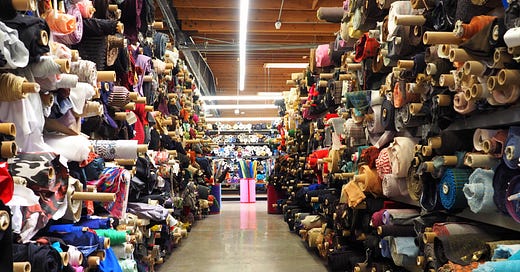



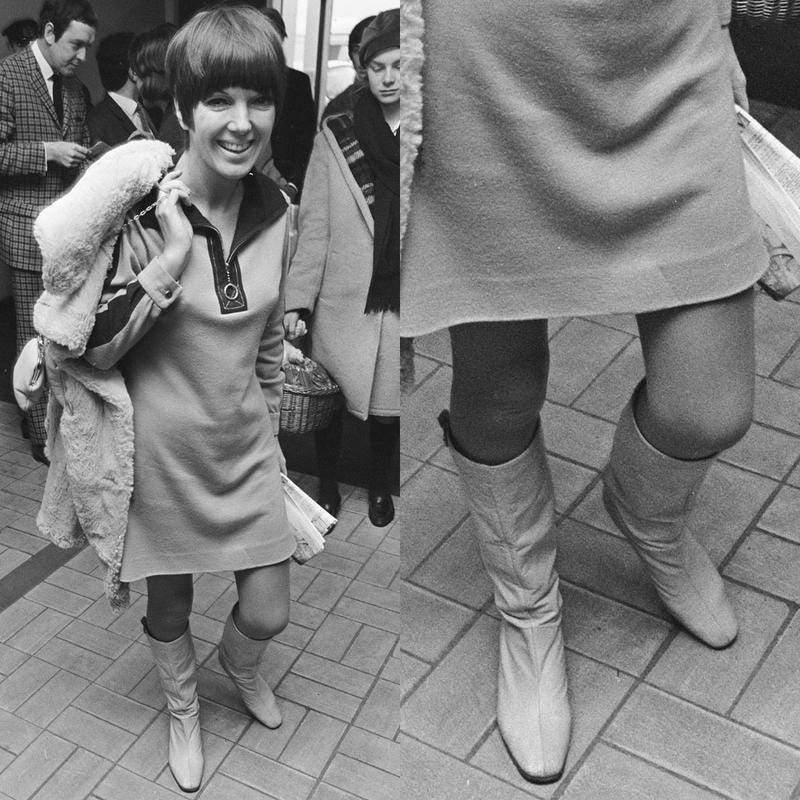


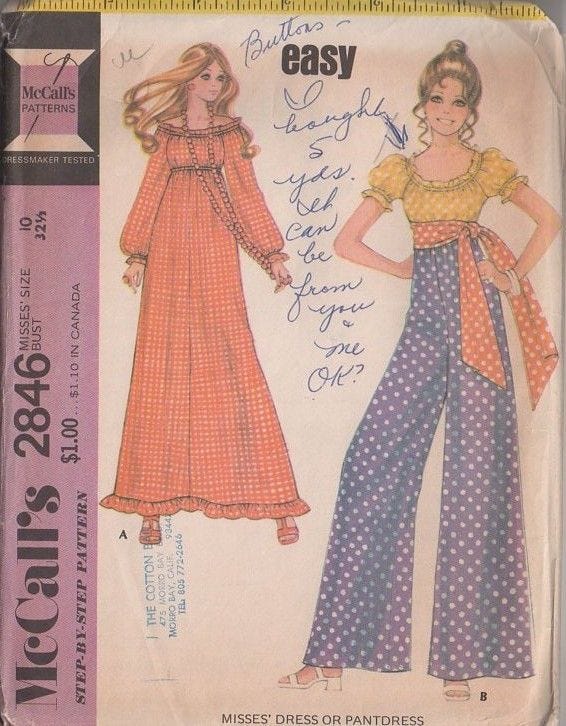
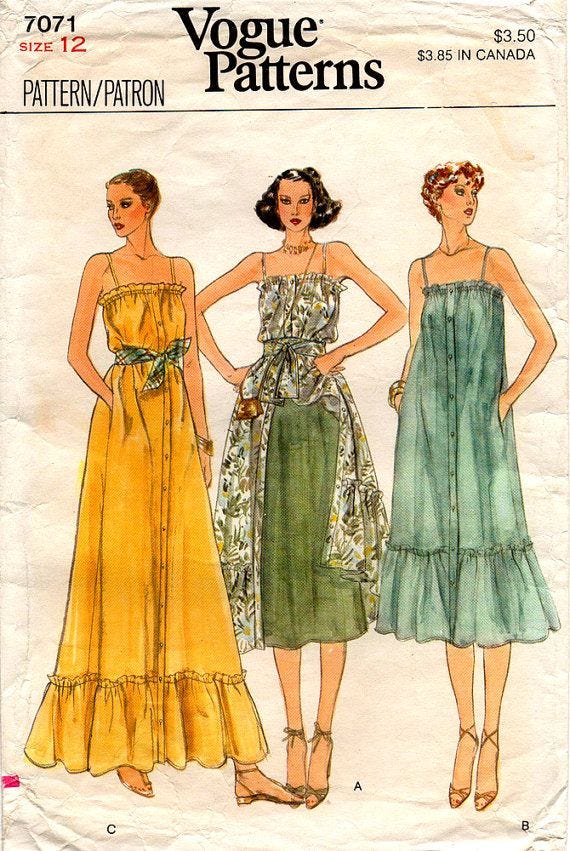

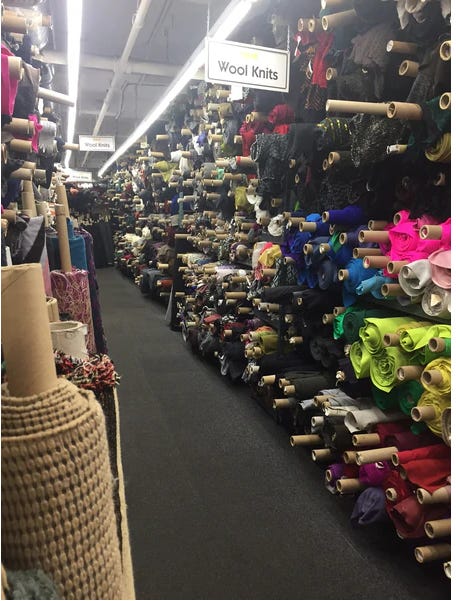
I can relate to this story in so many ways. My relationship with a sewing machine was similar, but my favorite thing was to buy vintage 40's clothing at the Salvation Army and alter it to to look "shabby chic". I had a Joan Crawford - style Kelly green wool dress with huge shoulder pads that became a mini-dress to wear with lace panty-hose and granny boots. I took apart a deep purple sequined jacket and put it back together to fit me. I loved the old fabrics and the fact that no one else had what I had. I made things from scratch too, like a black velvet cape with gathered shoulders and a hood. Very dramatic! When I went to FIT, (for photography) they were still rolling racks of clothing down the street in the garment district. I loved wandering through the fabric stores. I even worked part-time in Gimbel's in the notions department. Does anybody even know what notions are anymore? Thanks for taking me back!
I would love to see pics if your creations, with you as model, of course. I started sewing in 4-H at age 8 and did tolerably well through the years, also feeling over-qualified in home-ec. But my mom sewed many of my clothes or had them made for me due to issues with the fit of off-the-rack garments and my body type. Later on I was able to sew outfits for my kids until they refused to wear the adorable styles I chose for them, lol.